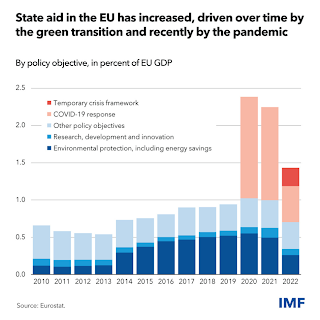(Credit: Tramino/iStock by Getty Images) By Alfred Kammer, Andrew Hodge, and Roberto Piazza Industrial policy is having a moment in Europe, as countries increasingly turn to sectoral policy interventions to address the challenges of geopolitical fragmentation and economic security, enhance productivity, and accelerate the green transition. State aid spending by European Union countries has tripled in the last decade, reaching 1.5 percent of GDP. Much of this aid flowed into green technologies and energy efficiency, with major economies like France, Germany, Italy, and Spain driving the surge. As the recent report from Mario Draghi suggests, there is a growing consensus that even more such spending is necessary to spur growth.  But before rushing ahead, it is important to take stock. A new IMF working paper shows that the success of industrial policy depends not just on how much is spent, but on spending it well: targeting the right priorities and avoiding costly missteps. When poorly designed and targeted, industrial policies tend to fail. Good intentions aren’t enough Under the right circumstances, industrial policy can deliver tangible economic gains and strengthen economic resilience. By being focused on addressing market failures—such as by fostering innovation in sectors with knowledge spillovers (think of green technology) or enabling regional clustering (think of Silicon Valley)—it can boost productivity and incomes. However, even the best-intentioned policies can backfire if poorly coordinated. Powerful interventions, such as subsidies or tax breaks, that expand production and lower costs in a particular sector in one country will have the opposite effect in another, undermining comparative advantages and creating inefficiencies. Model simulations offer cautionary lessons. Unilateral industrial policies are a losing strategy for most EU countries, given their openness to trade. Without careful design, unilateral policies risk triggering powerful spillovers and spillbacks across the region that outweigh their benefits. As another IMF working paper shows, this is already a concern: European state aid benefits recipient firms but is often detrimental to others.  Why coordination matters The solution is clear: Europe’s industrial policies need a unified, coordinated framework. When countries align their efforts, the benefits of industrial policy can outweigh the costs. Coordinated policies preserve the gains from trade, ensure a level playing field, and make full use of the EU’s single market.  Simulations underscore this point. In a scenario where the EU acts as an integrated region and adopts a well-targeted industrial policy, better outcomes are obtained than under fragmented, country-specific approaches. Coordination prevents costly distortions of production patterns and trade prices between EU countries. As workers and firms are assumed to move freely across the single market, this can maximize the policy’s benefits. Importantly, coordination can help cushion any adverse impact on regions that might otherwise lose out, including through potential use of intra-EU fiscal transfers, fostering solidarity across the bloc. Building a better framework Existing EU state aid rules provide a starting point but fall short of what is needed to guide strategic industrial policies across Europe. Better data sharing and unified programs could enhance transparency and trust among member states. A centralized decision-making body could streamline priorities and better allocate resources to areas of mutual benefit. The creation of the Airbus venture almost half a century ago showed that coordination at scale can work: this collaborative, multi-country initiative combined resources and expertise to create a globally competitive player. Similar efforts could unlock the potential of Europe’s green and tech transitions. Deeper integration is an essential part of the equation. A stronger single market for goods, services, and capital with more labor mobility would amplify the effectiveness of industrial policies, allowing firms to scale up (see also Regional Economic Outlook for Europe, October 2024). An ambitious EU budget or centralized fiscal capacity could further support shared priorities. Europe and beyond Europe’s industrial policies have global implications. Subsidies and trade adjustments don’t stop at the EU’s borders, underscoring the need for engagement with multilateral fora such as the World Trade Organization. The right industrial policies can help where markets fall short. By embracing coordination and integration, the EU can ensure its policies foster growth, innovation, and productivity—while avoiding costly pitfalls. —This blog is based on the IMF Working Paper “Industrial Policy in Europe: A Single Market Approach”, by A. Hodge, R. Piazza, F. Hasanov, X. Li, M. Vaziri, A. Weller, and Y.C. Wong of the IMF’s European Department. | 

























































